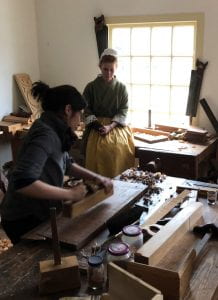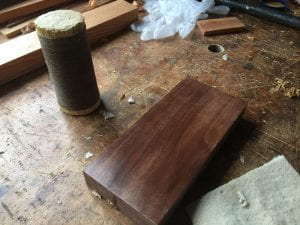Planed and Polished: The Joiner’s Shop at Colonial Williamsburg
By Anastasia Kinigopoulo, WPAMC Class of 2020
On our several of our stops in the trade shops, the group split in two. While some of us went to the shoemakers, my group went to work at the joiner’s shop. Joiners provided a number of critical services to the 18th-century community at Williamsburg. They produced furniture, of course, but also many of the individual parts of houses, everything from moldings to doors and window sash. As master joiner Ted Boscana explained, one could often identify the work of joiners by their use of pegs, particularly in the south. At the joiner’s shop, we were able to try a number of the tools used in the trade, especially the planes used to turn rough timber into finished wood.

Testing a scrub plane on a large piece of walnut. Photograph by Elizabeth Palms, WPAMC Class of 2020.
As the group took turns with the plane, we were surprised to find how little effort it took for the tool to work. Moving it across the wood with just the lightest effort, the iron (or blade) shaved off thin curls of aromatic wood. Though the initial stroke took a few moments to master, once I got the hang of it, I found myself almost mesmerized by the pleasant and productive action. Looking at the board in the light streaming through the windows, it was possible to see one’s progress as the surface became ever-smoother and glossier. Admittedly, I was far less enamored with the molding plane. Used to trim the edges of countless objects, that plane took far more effort to use efficiently.
After trying our hand at planning, we had the opportunity to apply various finishes to two pieces of wood—a triangle offcut of cherry, and a rectangular piece of walnut.

Examining the surface of a piece of cherry wood. Photography by Elizabeth Palms, WPAMC Class of 2020.
The first finish, to the cherry, consisted of beeswax, which gave the surface of the wood just enough of a sheen to bring out the iridescence of the grain. Finishing the wood in this way was simple: one rubbed the hardened beeswax on the triangle as hard as possible, scrapped off the excess, and then polished the wood with a tool called a polissoir. Mentioned and illustrated by eighteenth century French cabinet maker Andre Roubo in his L’Art du Mensuier, the polissoir is a small bundle of tightly bound broom bristles. Contemporary cabinet makers recently rediscovered the ingenious tool, which has enjoyed a comeback among practitioners of traditional woodwork. Rubbing the polissoir along the grain of the wood quickly brought out the beautiful salmon-beige color of the cherry.
Afterwards, we experimented with applying a shellac finish to a sample of walnut. After the surface was planed smooth, the wood first received a wax and pigment mixture to fill the open pores; we then scraped down and polished the surface, again with the polissoir. Once we had achieved a glossy, level surface, we applied a layer of shellac which had been dissolved in alcohol. Shellac, which is obtained from a tiny insect found in Asia, is used in a number of applications, including—perhaps alarmingly—some foods that the FDA has approved. The sticky substance, applied to the wood with a piece of cotton and cheesecloth, quickly dried, adding shine and depth to the surface.
Straightforward but highly effective, these techniques transform the surface a piece of wood from rough board to the mirror-like gloss so favored in the 18th century.



Leave a Reply